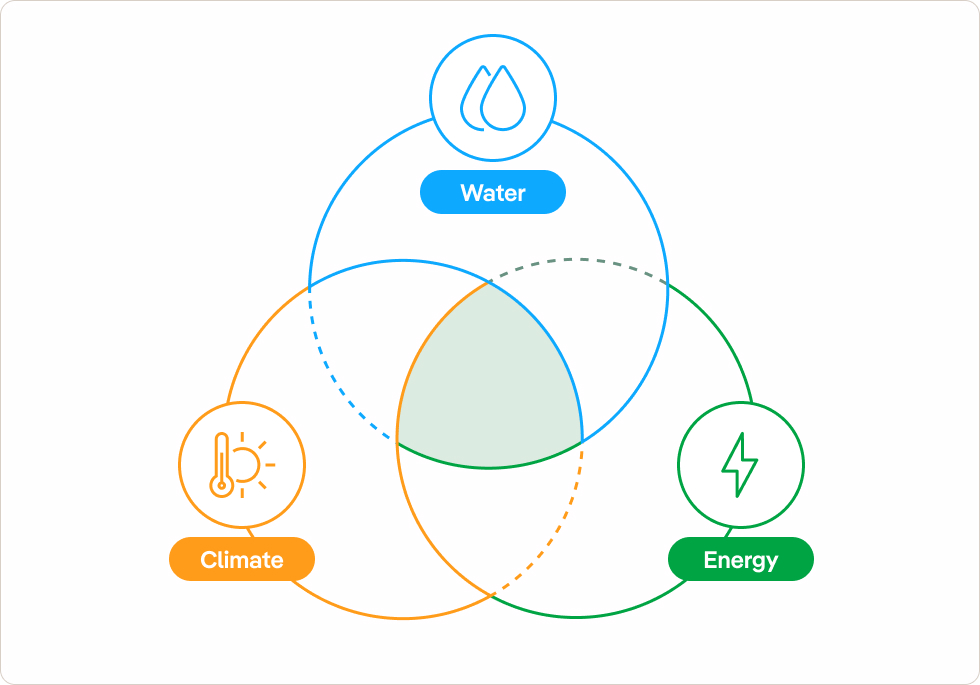Water systems and greenhouse gases
The role of water systems in greenhouse gas emissions

January 2022

Approximately 6 minutes

Fresh water is vital for all human activities, from growing food to manufacturing goods and services to supporting healthy natural ecosystems. Many of the advances and advantages of modern civilization have been the result of improvements in our ability to collect, treat, and distribute high-quality water to farms and growing cities, and to collect and treat wastewater to prevent pollution of our environment.
Water challenges to be solved?
Many difficult water challenges remain to be solved. Billions of people still lack safe drinking water and sanitation. Natural ecosystems are suffering from the loss of water humans take for ourselves. Political disputes and conflicts over shared water resources are growing. And the challenge of human-caused climate change threatens water resources in many ways, including rising temperatures and demand for water, increased severity of extreme events like floods and droughts, and new threats to water quality.
As we have learned how to manage water more effectively and sustainably, we have also learned that there are very close connections between water and energy - another complex global challenge - and that a sustainable future will require that these two important natural resources be considered together.
“Water-energy-climate” nexus factors
There are two important factors to consider in tackling this “water-energy-climate ” nexus.
Factor 1
The first is that a very significant amount of energy that we use goes to run our water systems – to collect, treat, distribute, and use water in our homes and industries, and to treat wastewater. In some parts of the world, as much as 20% or more of our total energy use goes to the water system, including the energy to provide hot water in our homes. And some of the newer approaches for expanding our water supply, such as seawater desalination, are extremely energy intensive. When this energy is provided by fossil fuels, it contributes to greenhouse gas emissions, worsening the very challenge of climate change that, in turn, threatens our natural water systems.

Factor 2
The second factor is that many of our traditional energy systems, like coal, oil, natural gas, and nuclear power plants, require large amounts of water for cooling. In the United States, as much as 40% of all water withdrawals are used by power plants. As pressures over water grow with populations and expanding economies, this demand for water will put more and more pressure on limited water resources. Even now, during severe droughts, some power plants in Europe, the United States, and elsewhere have had to shut down because of shortages of cooling water. As temperatures rise and droughts worsen in some regions, these problems will expand.
Gestión sostenible del agua
The good news is there are successful, sustainable solutions to each of these challenges at the nexus of water, energy, and climate. As more and more regions face peak water limits, where no new water can be found, a vital strategy for providing water and water services is to improve the productivity and efficiency of water use. We can, for example, grow more food with less water by using advanced irrigation methods like precision drip irrigation and better remote sensing of soil moisture so that farmers can water their fields in the right places and at the right times. Some industries and companies are working hard to be able to produce the goods and services society demands with less water and less energy. And home appliances like washing machines, dishwashers, toilets, and showerheads are all more water efficient today than just a few years ago. These technologies can reduce the amount of water needed while simultaneously reducing the amount of energy required to deliver those water services. Today, some of the most inexpensive ways of balancing the supply and demand for water is to improve the efficiency of water use, while also saving energy.
New strategies to expand supply can also be more energy efficient. Sophisticated new wastewater treatment plants, such as those that enable recycling and reuse now in use in Singapore, Israel, California and elsewhere, often require significant energy, but innovative technologies can capture the methane and energy produced during treatment and use it to power these new plants. The East Bay Municipal Utilities District's wastewater treatment plants in California, which serve more than a million people, now produce more energy than they use.

Generate clean energy and reducing the impact on water
There is also good news in the energy field: more and more of the sophisticated wind, solar, and other renewable energy systems now being built to help reduce greenhouse gases and eliminate the burning of carbon-based fossil fuels almost always require far less water than traditional power plants, permitting society to generate clean energy and reduce the impact on water resources simultaneously.
The water-energy-climate nexus is real, with strong connections among these three important global challenges. Smart strategies can help society protect and preserve our vital freshwater systems, reduce conflict and competition over scarce water resources, and simultaneously address serious energy challenges, cutting the energy and the greenhouse gas emissions associated with the water systems that are so critical to human civilization.
Peter Gleick is an American scientist working on issues related to environmental science, economic development, international security, scientific ethics and integrity, with a focus on global freshwater challenges. He worked at the Pacific Institute in Oakland, California, which he founded in 1987. In 2003, he was awarded a MacArthur Fellowship for his work on water resources. Among the issues he has addressed are conflicts over water resources, the impact of climate change on water resources, the right to human water, the problems of billions of people without safe, affordable and reliable sanitation. In 2006, he was elected to the US National Academy of Sciences.
Article published in issue 12 of Shapes in January 2022.






